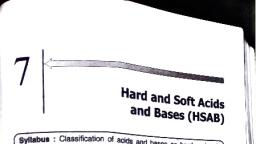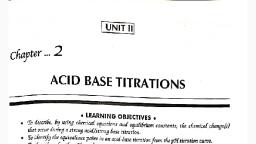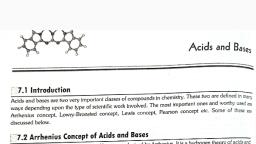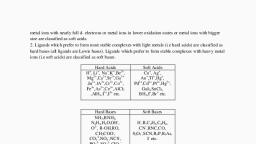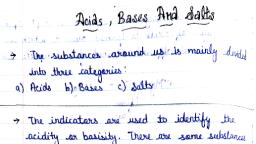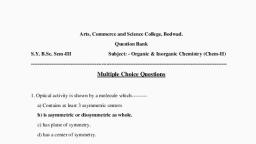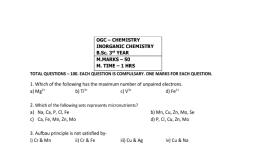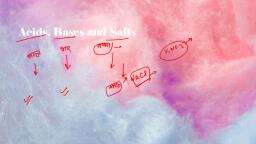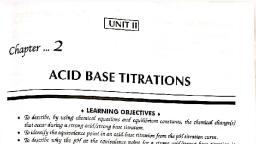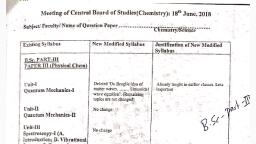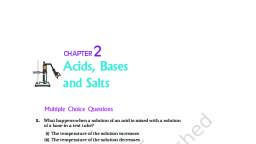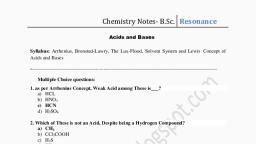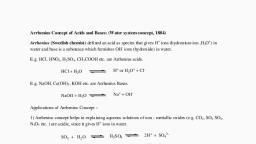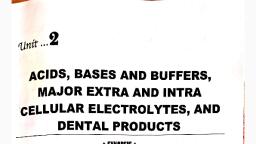Page 1 :
1. HARD AND SOFT ACIDS AND BASES (HSAB), Unit 1. Hard and Soft Acids and Bases (HSAB). [05], 1.1 Classification of acids and bases as hard and soft., 1.2 Theoretical bases of hardness and softness, 1.3 Pearson’s HSAB concept., 1.4 Acid – Base strength and hardness and softness., 1.5 Application and limitations of HSAB principle., , Introduction :, The Lewis concept failed to provide a definite and uniform scale to measure, the relative strength of acids and bases., The Lewis definition recognizes acid and bases in terms of their ability to, accept or donate electron pairs. The strength of an acid or a base can be determined, by the very nature of the reaction involved in a particular electron transfer process., On the basis of phenomenological criteria, suggested by Lewis, one may, predict that the displacement titrations can be made the basis for much, determination., For example in the reaction :, A+A’B = AB + A’, A’B is converted to AB one may predict that a is stronger than A’. It may be, said that the relative stabilities of acidbase complexes are used to, express the relative strengths .From above reaction.AB must be more stable than, A’B, Attempts have been made to correlate the different factors governing, strength , from enthalpies (∆H0) of acid – base reactions ., One of the difficulties in such determination was , with different reference, acids (or bases) different trends were observed in Kf , ∆G0 or ∆H0, For example :
Page 2 :
1., The complexing ability of the halide ions (Lewis bases)towards Al3+, increases in the order I- <Br-< CI- <F- But towards Hg2+the order is just reverse I->, Br- >CI- >F- ., 2., A similar reversal is seen in the heats of reaction of the acids I 2 and C6H5OH, with the bases (C2H5)2O and ((C2H5) 2S. Heat of reaction of I2 is greater with, (C2H5) 2S than that with (C2H5) 2O. But the trend for phenol is just reverse., Inspite of such difficulties ,to deal with the interactions of acids and bases, containing elements drawn from throughout the periodic table ,a qualitative, correlation between various Lewis acids and bases has been achieved ., In 1958 this was done, by Ahrland , Chatt and Davies by classifying the, acids or bases into general categories .Class – “a” and Class- “ b” According to, them the two categories of metal ions (Lewis acids)are as follows –, I) Class (a) – The metal ions which prefer to from stable complexes with the, ligands having donor atom of the first members of Gr.15 th(N),16 th(O), and 17, th, (F) in the periodic table . ., Examples are – Alkali metals , Alkaline earth metals and the first row transition, metals in high oxidation state (e.g.fe3+ ,Co3+.Etc. belong to class (a) acids ) ., ii)Class (b )- The other metal ions which prefer to from their most stable, complexes with the ligands having donor atom of the lower members of Gr.15, th(P,As,Sb),16 th(S,Se,Te), and 17 th(Cl,Br,I) in the periodic table . ., Lighter transition elements in low oxidation state and heavier transition elements, ,say Cu+ , Ag+,Hg+,Pt2+,Pd2+ etc. act as class (b) acids., 1.1 CLASSIFICATION OF ACIDS AND BASES AS HARD AND SOFT., AH:B1+ As+B2=AH :B2+As+B1, From above double displacement reaction it may be stated that B1 is softer, than B2 when K1 > 1 .On this basis a list of hard and soft acids and bases may be, obtained .See Table .1.1 The classification is not rigid and there occurs a gradation, from hard acids to soft acids ,and hard bases to soft bases , including the, borderline species.
Page 3 :
The criterion of hardness (or softness) is ascribed to the “hardness” of the, electron cloud associated with a particular species .A firmly held electron – cloud, having low polarizability makes the species “hard” while an easily polarizable, electron clowd characterisesthe species as “soft”.The third category with, intermediate characters will be a borderline .The details of distinguishing features, of hard and soft acids and bases are summarized in table 1.1, Table 1.1 Classification of Lewis Acids and Bases, Acids –, , (A), , Hard, , Borderline, , Soft, , H+, Li+ ,Na+, K+, , Fe2+ Co2+ Ni2+, , Cu+,Ag+,Au+,TI+, , Be2+,Mg2+,Ca2+, , Cu2+ ,Zn2+,Pb2+, , Hg+,Pd2+,Cd2+,, , Cr2+,Cr3+,Al3+, SO3,BF3,BCl3, HX(H-bonding), , SO2,BBr3, , Pt2+,Hg2+,BH3,Br2, Br+,, M0 (metal atoms) and, bulk metals, , Features :, Hard, Acceptor atoms are marked by:, 1), 2), , 4), , Small size, , Soft, Acceptor atoms are marked by:, 1), , Large size, , High positive oxidation state., 2) Zero or low positive oxidation state, 3) Absence of any outer electrons Which, 3) Presence of several excitable valence, are easily excited to higher States., shell electrons., Absence of d-electrons., , 4) With nearly full d-electrons.
Page 4 :
5), , 5) Mostly heavy metal ions., , Usually light metal ions., , Know as Lewis acids which Are not6 6) Known as Lewis acids and are easily, polarizable. Prefer to, easily polarizable Prefer to coordinate with coordinate with soft bases., hard, 6), , (B) Bases :, , Hard, F-,OH-,H2O,NH3, CO32-,NO3-,O2-,, SO42-, PO43-CIO4-,(Cl-), , Borderline, NO2,SO3,BrN3-,N2,C6H5N,, SCN-, , Soft, H-,R-,CN-,CO,I-,, SCN-,R3P,C6H6,, R2S., , Features :, , Hard, 1) High electronegativity., 2) Low polarisability., 3) Presence of filled orbits ; empty, orbitals may exist at high energy level., 4) These are anions or neutral molecule, known as Lewis bases or ligands, prefer, to co-ordinate with hard acids., , Soft, 1) Low electronegativity, 2) High Polarisability., 3) Partially filled orbitals, empty, orbitals are low- lying., 4) these are anions or neutral molecules, called similarly as Lewis bases or, ligands, prefer to bind with soft acids.
Page 5 :
From the Table 1.1 it is clear that there is no line of demarcation between, hard soft species., Within each group ,there exists no equal hardness or softness e .g. Alkali, metal ions are all hard but within the group : Li + >Na+ > K+ > Rb+ >Cs+ hardness, decreases hence Li+ is hardest while Cs + is softer ,as it is larger and more, polarizable as compared to Li+, Similarly nitrogen is a hard base say as NH3 being of a small size and if, polarizable substituents are present, it will turn to be sufficiently softer e.g., Pyridine ,where polarizable substituents are present .Further we may use terms, such as, “a moderately weak and fairly soft” “very hard but weak” by considering the, strengths of acids and bases., 1.2 PEARSON’S CONCEPT, In 1963 R. G. Pearson extended and generalized the qualitative correlation, between Lewis acids and Lewis bases by classifying them into two categories, Hard and Soft., The class –‘a’ metals which are small and less polarizable, prefer to combine, with non- metals or ligands which are also small and not very polarizable ,, pearson called such metals as Hard Acids and the corresponding ligands as soft, Bases., Similarly the class ‘b’metals having large size ,more or easily polarisable,, prefers to combine with non-metals or ligands having similar properties Pearson, called such metals as soft acids and the ligands as soft base, The attempt of classification of acidsand bases as hard and soft by Pearson, is known as Hard and soft Acids and Bases .(HSAB) or pearson’s concept, Principle of Pearson’s concept :
Page 6 :
Pearson suggested a simple rule (Sometimes called Pearson’s principle ) for, predicting the stability of complexes formed between hard and soft acids and, bases., “Hard acids prefer to bind (co-ordinate ) with hard bases and soft acids, prefer to bind with soft bases and gives stable complex compound ”., It should be noted that the statement given above is not a theory or an, explanation but it is simple rule of thumb which enables us to predict the relative, stabilities of acid-bases adducts qualitatively., 1;2Theorotical basis of hardness and softness, Several theories have been given to explain the stability of complexes, Formed by hard-hard and soft-soft interactions. Some important theories, are:, (a) Ionic and covalent bond theory : According to this theory ionic bond is, formed by the interaction of hard acids and hard bases wheras covalent, bond is formed by the interaction of soft acids and soft bases. The, electrostatic force of attraction between two oppositely charged ions is, inversely proportional to the internuclear distance. The internuclear, distance will be less in case of smaller ions. Therefore, the electrostatic, attraction between two ions will be greater and consequently the, resulting compound will be highly stable., Covalent bond is formed by the interaction of soft acids and soft bases., This is because the soft acids and soft bases have laege size. The, polarization effects are, therefore important to explain their interactions., Soft acids are generally transition metal ions having six or more delectrons. The d-sub shell are easily polarized. Therefore, the, complexes formed by soft acids and soft bases have covalent bonding, and are stable., In order to predict the hard and soft nature of given acid or base,, Misons and his coworkers (1967) gave the following relation-
Page 7 :
pK=-logK=AX+BY+C, wher X and Y are the parameters for the acids, A and B are the, parameters for the bases, C is a constant which adjust pK values in such, a way that all of them lie on the same scale and K is the equilibrium, constant for the dissociation of acid base complex. The values of, parameter Y for some of the acids (cations) are given belowHard acid, Parameter Y, Soft base, Parameter Y, +, +, Li, 0.36, Cu, 3.45, Al3+, 0.70, Tl+, 3.78, Na+, 0.93, HG2+, 4.25, Ca2+, 1.62, Au+, 5.95, Fe3+, 2.37, The acid is hard if the value of parameter Y is less than 2.80 and the, acid is soft if the value of Y more than 3.20. For border line acid the, value of Y is in between 2.80 and 3.20., The value of parameter B for some of the bases is given belowHard base, Parameter B, Soft base, Parameter B, OH, 0.40, I, 7.17, NH3, 1.08, S2O3212.40, Cl2.49, The base is hard if the value of parameter B is less than 3.0 and the base, is soft if the value of B is more then 5.0., The value of X and A also give information about the hard and soft, nature of an acid and a base., (b) - Bonding theory : This theory was given by Mulliken (1955) and, chatt (1956) to explain soft –soft interaction on the basis of -bonding., Soft acids have low oxidation state and have a large number of delectrons. Thus, they have a strong tendency to form -bonds with soft, base which are also good –bonding ligands. The polarization of soft, acids and soft base also favour -bonding., (c) Pitzer’s theory : According to Pitzer, London dispersion energies, stabilize a bond between two large polarizable atom . These energies
Page 8 :
increase with an increase in the size and polarizability . this is why,softsoft interactions are more stable as compared to soft-hard interaction., 1.3 ACID-BASE STRENGTH AND HARDNESS-SOFTNESS, Inherent acid –base strength is quite distinguished feature from the hardness, and softness., Hardness - softness pertains to the stability achieved due to hard-hard and, soft – soft interactions., The insight can be collected from the following observations ., 1. i) OH- and F- are hard bases where OH- is 1013 times stronger base than, F2-, , ii) Et3 P and So3 are both soft bases where Et3 P is 107 times stronger, base than so2-3 towards CH3Hg+, These facts pertaining to inherent strength violate the Pearson’s principal “ Hard, prefers hard soft prefers soft ”, , (a) Soft base SO 2-3 can displace hard base FSO32- +HF -------------HSO3- + F-, , Keq=104, , (b) Hard base OH- can displace soft base SO32From soft -soft combination of CH3HgSO3OH- + CH3 HgSO3- -------------CH3HgOH+SO32- Keq=10, , In these cases the strengths of bases are SO32- > F- and OH- > SO32-are, enough to force the reactions to right irrespective of hard soft considerations., 2., If both strength and hardness softness are applied under competitive, conditions the hard soft rule will be found to be applicable.
Page 9 :
e.g., i) CH3HgOH+HSO3- ------------CH3HGSO3- + HOH, , Keq 107, , soft hard Hard Soft, , ii) CH3 HgF +HSO3-. -----------CH3HgSO3-+HF- –, , Keq 103, , 3. While acid-base interactions are considered one has to account both strength as, well as hardness softness ., Tble 1.2: Basicity toward (H+) and (CH3Hg+), Base, FIOHS2SO2-3, NH3, Et3P, CN-, , Linked atom, F, I, O, S, S, N, P, C, , pk(CH3Hg+), 1.5, 8.6, 9.37, 21.2, 8.11, 7.6, 15.o, 14.1, , pkn(H+), 2.58, -9.5, 15.7, 14.2, 6.79, 9.42, 8.8, 9.14, , Table 1.2 enlists the strengths of different bases toward methylmercury, cation CH 3Hg + and the proton (H+) .From the data it seems that the bases such as, triethylphosphine (Et3P) and the sulphides S2 –ion are very strong toward both, CH3Hg+ and H+ But both Et3 P and S2-ion are about a million times better toward, CH3Hg+ , hence both are considered to be soft bases., The OH- ion is a strong base toward both acids CH3Hg+ and H+ but it is, million times better base towards acid,H+ Hence OH- is hard., The F- ion is not a good base toward CH3Hg+or H+ but little better toward, H+ as it appears from its hardness ., 1.4 APPLICATIONS AND LIMITATIONS OF HSAB PRINCIPLE
Page 10 :
1.4.1 Applications, With the help of HSAB a large number of chemical reactions can be, understood., 1.Relative strength of Hydracids HF,HCL,HBR and HI :, In aqueous solution the relative strength of HF,HCI,HBr and HI can be, predicted., The reaction of acids with water is:, HX+H2O→H3O++XThe hardest base F- will be most successfully and strongly bonded to the hard, acid H+ Hence HF Will be highly stable.It is therefore least dissocated.Hence, acid strength increases as :, HF < HCI < HBr < HI, 2., , Relative stabilities of complexes in Aqueous Solutions :, , HSAB entails that[ Cd(CN4)]2- is more stable that [Cd(NH3)4]2+ According to, HSAB principle hard prefers hard and soft prefers soft.Hence the soft acid Cd 2+, will prefer to corrdicate soft base CN-It is clear from the Kinst constants where, cyano complex has Kinst = 1.4x10-19 while for ammine complex it is 7.5x10-8 .Thus, cyano is stable., 3., , To Predict the Course of Reaction :, i), , H+ CH3HgOH→H2O+CH3Hg+, , ii), , H+ +CH3HgSH→H2S+CH3Hg+, , The reaction (i) goes to right as the hard acid H+ binds strongly to hard base OHto produce stable product H2O, On the other hand the reaction (ii) is favoured to left where soft base SH will, tend to remain combined with soft acid CH3Hg+ instead of joining to hard acid H+
Page 11 :
4.Classification of Cations : Fig 1;2, The Fig 1.2 shows the trends in equilibrium constants for formation of, complexes with halide ion – bases., The Values for Kf increase steeply from F- to I- when acid Hg 2+ is used, indicating it to be markedly soft .The curve is less steep but in the same direction, for Pb2+ which indicated that Pb2+ is a borderline soft acid .The trend is in, opposite direction for Zn2+ with moderate steepness from I- to F- .Hence it must be, hard but borderline hard acid .The very steep downward slope for AI3+ indicates, clearly that AI 3+ must be a hard acid .Thus the opposing trends in the reactivity of, the halide ions towards Al3+ (F- > > CI -> Br - > I- ) and Hg2+ (F- > > CI -> Br > I- ) are now easily rationalized ., 5. Classification of Netutral Molecular Compounds :ecular Compounds :, For neutral molecular acids and bases a similar Classification hard and soft, can be applied .For example the Lewis acid phenol (C6 H5OH) forms a more stable, complex by hydrogen bonding to diethyl ether (C2 H5) 2O than the thioether (C2, H 5 )2 S. In contrast the Lewis acid I2 forms a more stable complex with (C 2 H5)2S, Hence we conclude that phenol is hard whereas I2 is soft., 6 . Pauling Pearson Paradox :, Hard hard and soft soft combinations determine the course of number of, typical reactions for example, LiI + CsF →LiF + CsI, HgF2 + BeI2 →BeF2 + HgI2, These reactions will illustrate the Pauling – Pearson Paradox of, chemistry .As far as pauling’s electro -negativity concept is concerned, caesium and mercury should form more stable bonds with fluorine as their, electro negativity differences are greater., In reality however LiF if more stable thatn CsF (and BeF2 than HgF2 ), It is due to very large contribution of electrostatic interaction between Li + and, F- and (Be2+and 2F -)
Page 12 :
In Fact the major driving force for the above combinations comes, from the stability of the hard - hard combination occurring between small, atoms joining by ionic bonding and/or covalent bonding .The soft - soft, combinations contribute little or nothing to the driving force except when, other factors like, bonding are involved .The following data of enthalpies, of atomization will support the facts., Li I +, , CsF →, , Hard -soft, , Hard -soft, , 347, , 501, , Hg F 2, , +, , Hard-Soft, , CsI, , Hard- soft, 573, →, , BeI2, , Hard -soft, kjmol-1, , 335, , Hard- Soft, , 535, , 7, , Li F +, , BeF2, Hard- Soft, , 577, , 1262, , + HgI2, Hard -Soft, 292, , kjmol-1, , Symbiosis :, , BF 3 is a hard acid combines readily with a further F-- ion which is a hard, base .While BH 3 being a soft acid prefers to join the softer base H- ion .This fact, will easily account for the following :, BF3H- +, CF3H +, , BH4F –→, , CH3F →, , CF4, , BF4- +, +, , BH4-, , CH4, , Such tendencies of fluoride ions or hydride ions to favour further co, ordination by a fourth F- and H- ion has been termed “symbiosis” by Jorgensen, (1964) for the symmetrically substituted species with a centre already having soft, ligands or vice Versa., 8., , General Chemical Aspcts :, , Number of chemical aspects have been interpreted by the HSAB or SHAB, concept.
Page 13 :
(a), , Catalytic power of metals may be accounted from the fact that, the soft metal atoms will easily adsorb soft bases on their, surface., , (b) Solubilities may be understood from the fact that the hard, solvents will prefer to dissolve hard solutes and soft solvents, dissolve soft solutes e.g .Hg.(OH)2 dissolves in acidified aqueous, solvent but HgS does not., (c) Substitution reactions can be kinetically studied from hardness, and softness of species concerned., (d) Some additional illustrations of HSAB concept are, (i) MgCO3 CaCO3 AI2O3 occur in nature but MggS CaS or AI2S3 do not, (ii) CU+ Ag+ Hg+ occur in nature as sulphides., (iii), , [CoF6]3- is more stable than [CoI6]3-,[Co(NH3)5F]2+ is stable, [Co(NH3)5I]2+ is unstable.ets., , (iv), , [Ag(CN)2]- is very stable but[AgCI2]- is very unstable., , (v) [AgI2]- (produced by soft-soft combination)is stable and exists while, [AgF2]-( produced by soft-hard combination) does, not exist., (vi), , Ammonia.water.fluoride ion ets. Prefer to bind to Be2+ Ti4+ Co3+, ect and give very stable complxes., , vii) Phosphines (R3P) thioethers (R2S) and other species of P and S, as donor atoms prefer to bind to Pt2+ Pd2+ Hg2+ ect ., Referring to Table .1.1 all such cases may by easily tackled by soft hard hard soft - soft or hard soft combinations relating to the person rule., Energetic of Hardness :In general hard acids are identified empirically by, their preferential binding of lighter basic atoms within the group., e.g. For hard acids : Kf +F- >> CI- > Br- > I- > R2O> > R2S R3N > > R3P, Conversely the soft acids are indentified empirically by showing the, opposite trend down the groups:
Page 14 :
For soft acids :Kf = F-< < CI-< Br- < I - R2O< < R2S R3N << R3P, 1.4.2 Limitation of HSAB Concept /Principle, Hard and soft classification is useful concept no doubt but it has, some tricky limitations as pointed out below., 1. The prime limitation f the HSAB concept is that it is widely general, and has no any direct quantitative scale of acid base strength ., 2. The inherent acid base strengths are not accounted for e.g.OH- and, F- ions are both hard bases where OH- is nearly 1013 times stronger, base than F ions .Correlation between hardness and inherent acid, base strength is yet to be developed., 3. Interpretation of different reactions by splitting the participants into, acid base fragment is quite arbitrary to some extent. The reaction, between ethanol and acetic acid may be interpreted for esterification, in two ways:, Break I, , CH3COO-H+ C2H5OH-, , Break II, , Ch3Co+ OH + C2H5O-H+, , The hard-hard combination of H+, The hard combination of H+ with OH- for both is justifiable .But there, is nothing to exclude the break (I) on the basis of hard –soft, interactions between CH3COO – and C2H5+, 4. Sometimes Hard Soft principal fails to keep parity with inherent, acid-base strengths., e.g. CH3(g + H2(g –CH4(g) + H+ g), This reaction must be favoured in the view of soft soft combination, between CH3 and H- .But in actual practice the combination is, endothermic by about + 360KJ moI-1 .This unfavourable entropy, chage dose not allow the reaction to proceed.
Page 15 :
(In favour of reaction the explanation may be given in terms of the, greater acidity of proton H+ relative to CH3+ cation ), 5. Hard soft combinations occur in many cases., e.g. SO2-3 +HF – HSO3-+F, Here it appears that the soft base SO23- has replaced the hard base, F- and combines with hard acid H+ (Here the soft base SO23- must be, stronger than the hard base F-), , With these few illustrations it is worth to recall R.G.Pearson who, says., It should be stressed that the HSAB principal is not a theory but is a, mere statement about experimental facts Accordingly an explanation, of some observation in terms of hard and soft behavior does not, invalidate some theoretical explanation., CONCLUSION, To sum up it may be predicted that the importance of HSAB, approach lies in its utility to systematize a good number of, experimental observations leading to the study of relative stabilities, of complexes. The point worth nothing is that the soft soft, interactions are not the driving forces of the reactions. They are, merely the consequences of the driving species that are in bonding, process., In the case of Lewis acids which are the transition metal ions that, appear to expand their octets the bonding may be actually stabilized, by the soft soft interactions which lead to covalent bonding, accompanied by bonding as well .At present this is only a, speculation !
Page 16 :
QUESTIONS, 1. Select the correct alternative for the following:, (i) Pearson’s Principle state………., (a) Hard prefers to bind hard., (b) Hard prefers to bind soft., (c) soft prefers to bind hard., (d) Hard prefers to bind hard soft prefers to soft., (ii) Li+ is the…., (a) Soft base., , (b) hard base, , (c)soft acid, , (d) hard acid, , (iii) Classification of acids and bases as HASB is due to….., (a) Lewis, , (b) Arrhenius, , (c) Bronsted, , (d) Pearson, , (iv) For hard acids, KfΞ F->>Cl->Br->I(a) False, (c)For soft acids, , (b) reverse is true, (d) correct, , (v) H+ is called as hard acid whereas, H- is a soft base., (a) Faslse, (b) reverse is true, (c) H+ called soft acid, (d) correct
Page 17 :
vi)Which of the following is hard acid, a) Pt2b)Ag+ c) Hg2+ d) Li+, vii) Which of the following is soft base, a)NH3 b)H2O c)OH- d)Iviii) ------is the borderlined acid, a)Ag+ b)Al3+ C)k+ d)Zn2+, ix)----Complex ion is stable, a)[AgF2]- b)[Cd(NH3)42+ c)[CoI6]3- d)[AgI2][Ans: aleternate (d) for all]., 2. Define the following :, (i) Pearson’s rule, , (ii) Hard acid, , (iii) Soft base, , (iv) Boarderline acid v)Hard base vi)Soft acid, , 3. Write short note on :, (i) Pearson’s Principle, (ii) Hard/Soft base, (iii) Hard/Soft acid, (iv) Limitation of pearson’s rule, (v) Applications of HSAB concept, 4. Give a brief account of classification of acid as hard and soft., 5. Give an account of acid-base strength and hardness-softness., 6. How do you classify bases as hard and soft according to pearson’s rule., 7. Write precisely on classification of acids and bases as hard and soft.
Page 18 :
8. Comment on HSAB concept with suitable examples., 9. What do you know about acids-base strength and hardness- softness., 10. Write a critical note on applications and limitations of HSAB principle., 11.What do you mean by Hard and Soft acids and bases?Give their characteristics, and classification., 12. Discuss the therotical bases of hardness and softness.How are they related to, acid- base strength and electronegativity, 13. According to pearson’s rule distinguish between a)Hard acid and soft acid b), Hard base and soft base, , .

